Visualization Techniques For Prepositional-Case System In Teaching Russian Language For Foreign Students
Abstract
The paper presents one of the possible solutions to the urgent problem teachers face when teaching Russian as a foreign language for engineering students at the faculty of pre-university training. The problem is associated with the need for improving the literacy of students and eliminating mistakes related to confusion or ignorance of the meanings of Russian cases. The authors used their teaching experience to develop a methodology that employs innovative fishbone and mind map techniques in order to visualize the meanings of the six Russian cases and the constructions with these case meanings. The methodology was developed with due regard to the peculiarities of thinking and perception of information by students of engineering specialties and the requirements of the modern educational paradigm that exhibits a gradual replacement of linear texts with polycode ones. The paper describes the two innovative techniques adapted by the authors for teaching RFL, substantiates the methodological expediency of using the fishbone diagram at A1 level and the mind map at A2 and B1 levels, and proposes an algorithm for working with these techniques at different levels of teaching Russian as a foreign language – elementary, basic and the first certification level. The experimental results showed the effectiveness of the described techniques, which provide the formation of systemic knowledge about the prepositional-case system of the Russian language and the communicative competencies of foreign students of engineering specialties.
Keywords: Russian as a foreign language, prepositional-case system, innovative techniques, visualization of educational information, fishbone diagram, mind map
Introduction
The prepositional-case system of the Russian language is considered one of the most difficult grammatical topics. Foreign students make mistakes at almost all stages of learning the Russian language, both when changing the case of a word (in case endings) and when choosing the case (inconsistency of the case meaning with a communicative task).
A broad methodological base for teaching RFL at the Peoples' Friendship University of Russia is constantly replenished with innovative technologies, methods and techniques that contribute to the effective mastering of educational material to make it more systematized, illustrative, understandable and memorable.
The paper describes innovative techniques developed and successfully tested by the authors in classes in Russian as a foreign language at the Faculty of the Russian Language and General Education Disciplines, and in the Engineering Academy of the Peoples' Friendship University of Russia (Russia, Moscow) (Kalinina, Mikheeva, 2019 ).
Problem Statement
The innovative techniques developed by the authors meet new challenges and requirements of the 21st century, which imply a fundamental change in the presentation of information. The traditional linear representation of information turns out to be ineffective and is substituted by polycode text, which includes both the verbal linguistic part and the non-verbal one that refers to other systems (visual, audio, etc.) (Russian language, 2019).
Based on personal experience of working with students of various specialties (both the humanities and exact science), the authors came to the conclusion that perception of a linear text is difficult for students of engineering specialties, which is associated with the peculiarities of their thinking and perception of information. Thus, to increase the motivation of students and the efficiency of mastering educational material, a teacher working with students of engineering specialties should transform traditional linear texts into algorithms to adapt them in accordance with the peculiarities of 'technical' thinking. This is especially relevant for introduction and revision of Russian cases and their meanings.
Research Questions
The authors focused on two innovative techniques of foreign authors-developers – fishbone diagram and mind map – and adapted them for visualization of educational information in teaching RFL. The authors consider that the fishbone technique is suitable for teaching Russian for A1 level students and the mind map technique can be used for teaching A2, B1 level students when distinguishing between cases of using case meanings with and without prepositions.
The fishbone diagram was developed by Japanese management theorist Professor Kaoru Ishikawa (Ishikawa, 1990):
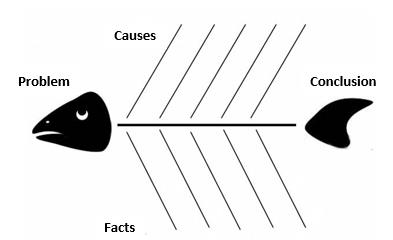
According to the methodology proposed by the authors, A1 level students, when studying the meanings of a particular case, fill in the lower part of the Fishbone diagram under the guidance of a teacher: the case meanings are presented in the form of a structural diagram or a nominative unit. Then, generalized meanings are indicated at the top of the diagram, and the main (abstract) meaning of the case is fixed in the 'tail' of the 'fish'.
The term 'mind-map', also known in Russia as 'mental map', 'intellect map', 'memory map', was introduced by the British psychologist Tony Buzan (Buzan, 2004), who developed a unique method of organizing and memorizing information (Buzan, 2002a; Buzan, 2002b; Gelb, Buzan, 1996):
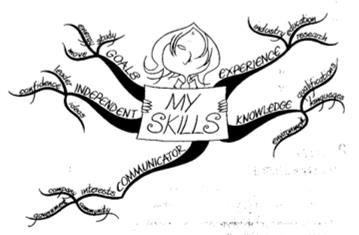
Such mind maps are common in Russia and are widely used in the educational process (Akhmedova, 2020; Syrina, 2016: Goncharova, Shitova, 2015).
The authors developed an algorithm for working with mind maps: under the guidance of a teacher, students create mind maps to add new case meanings; in the upper part of the map, the case meanings are written without a preposition, and in the lower part – with a preposition.
The authors compiled the fishbone diagrams and mind maps (Kalinina, Mikheeva, 2019) for A1, A2 and B1 level students, which correspond to the meanings of the Russian cases described in the State Educational Standards and Requirements for Russian as a foreign language of the corresponding levels (Vladimirova, 2001; Nakhabina, 2001; Andryushina, 2009).
Purpose of the Study
The purpose of the study is to describe the algorithm for working with the meanings of the nominative case using innovative techniques for visualizing educational information – Fishbone diagrams (A1 level) and mind maps (A2, B1 levels) – based on a set of tasks developed by the authors in addition to the main educational and methodological complex.
Research Methods
The authors employed general scientific methods (analysis, synthesis, observation, commenting, comparison, generalization) and special methods, such as the method of linguistic experiment and the quantitative method. The experiment involved two groups of students: the experimental group worked with the meanings of the nominative case using fishbone diagrams and mind maps, and the control group did not use innovative techniques. The results of the experiment are presented in Figure 03:
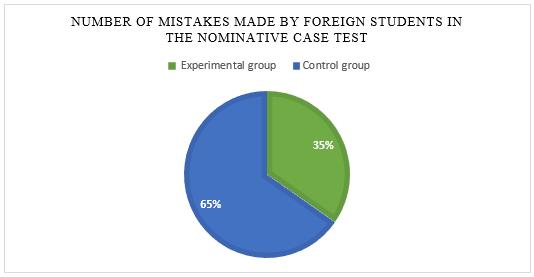
Findings
To create a universal methodology for visualizing educational information, the authors have developed a set of exercises that can be included in the educational process at different levels of teaching RFL. The exercises are designed to practice intonation structures (A1 level), update the studied vocabulary (Andryushina, Kozlova, 2015b; Andryushina, Kozlova, 2015a), systematize all the meanings of the nominative case in accordance with A1–B1 levels and diversify the educational process using game tasks.
A1 level
The diagram below is taken as a base diagram:
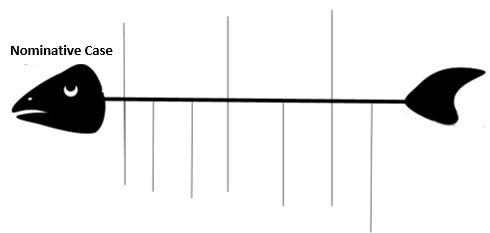
Note that the teacher must control that students fill in information in the correct column at the bottom of the diagram, because students will need to determine the groups of meanings to formulate the generalized meaning of case 1.
Change the sentence according to the model:
Model: This is Anton. (1) → − Is this Anton? (3) → − This is Anton! (5)
− Here is the book. (1) → − Where is the book? (2) → − Here is the book. (1) → − Here is the book! (5)
1) This is a house. (1) → − … …? (3) → − … …! (5)
2) This is a pencil. (1) → − … …? (2) → − … … . (1) → − … …! (5)
Fill the diagram with the structure 'This is/Here is + N1':
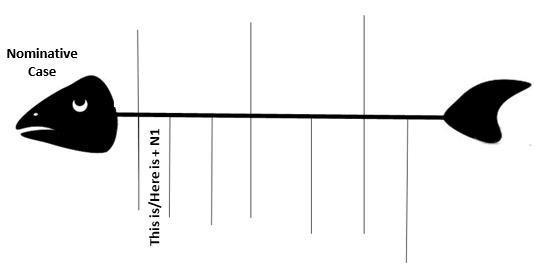
Task 2. Read the dialogues with the correct intonation. Find the constructions with the nominative case (case 1). Fill the Fishbone diagram with the nominative meanings.
1)− Anton, is physics a science? (3)
− Yes, physics is a science. (1)
− And chemistry? (4)
− Chemistry is also a science. (1)2) − Ira, when is supper? (2)
− Supper is soon. (1)
− What is for supper? (2)
− Fish and potatoes. Then juice and fruit. (1)
New meanings are introduced into the diagram:
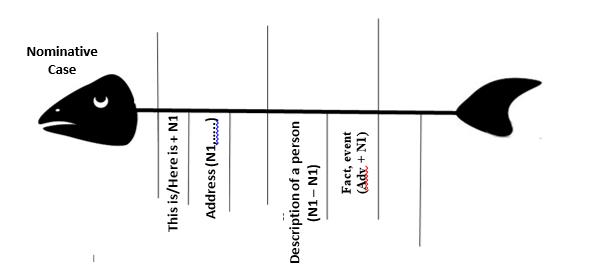
Task 3. Role play mini dialogues. Fill the fishbone diagram with new meanings.
1)– Is this a university?
– …
– And where is the dormitory?
– …
2)– Do you have a family?
– …
– Where do your parents live?
– …
3)– What is your name?
− …
− Are you a student?
− …
− What disciplines do you like?
− … 4)– Do you have a friend?
– …
– What is his name?
– …
– Does he work? What is he?
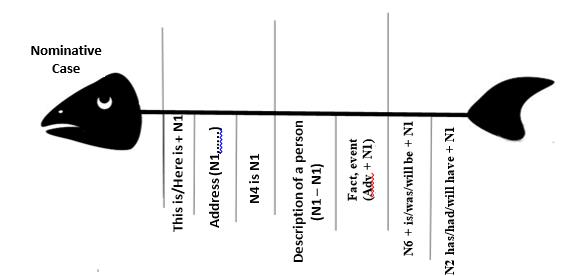
Describe the pictures using reference words. Fill the fishbone diagram with a new meaning.
Reference words: be ill, walk, play, have dinner, sleep, read.
The new meanings are introduced into the diagram:
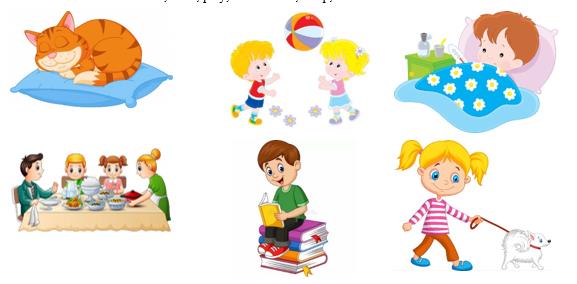
After that, students analyze the resulting diagram and generalize the meanings of the nominative case. This generalization is methodologically necessary, since it helps memorize communicative situations of using the nominative case:
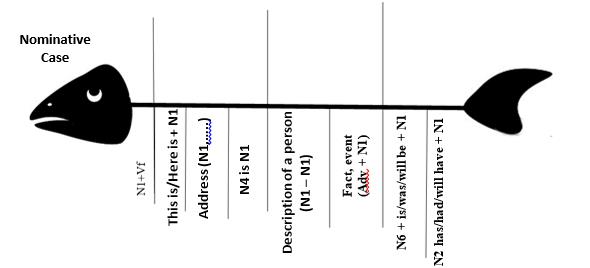
The final stage of working with the diagram is to determine the invariant meaning of the nominative case – the name of a person or object:
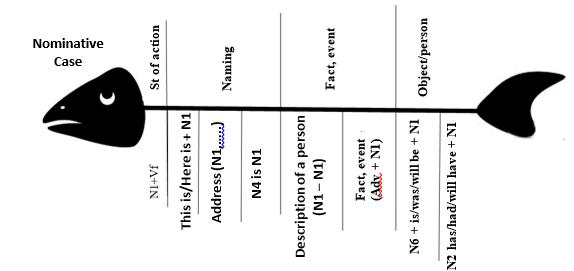
А2 level
The following exercise can be used to create communicative situations in which the nominative meanings are realized, as well as to check the correct filling of the Fishbone diagram or (this option is more preferable) when moving to A2 level, when foreign students need to transfer the nominative values they know to the new diagram.
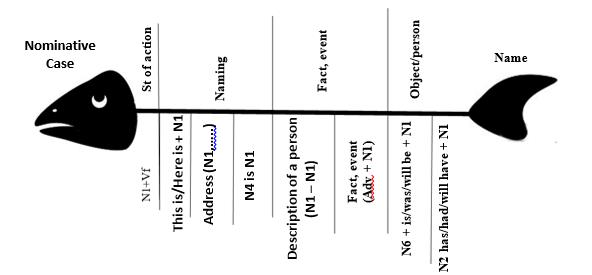
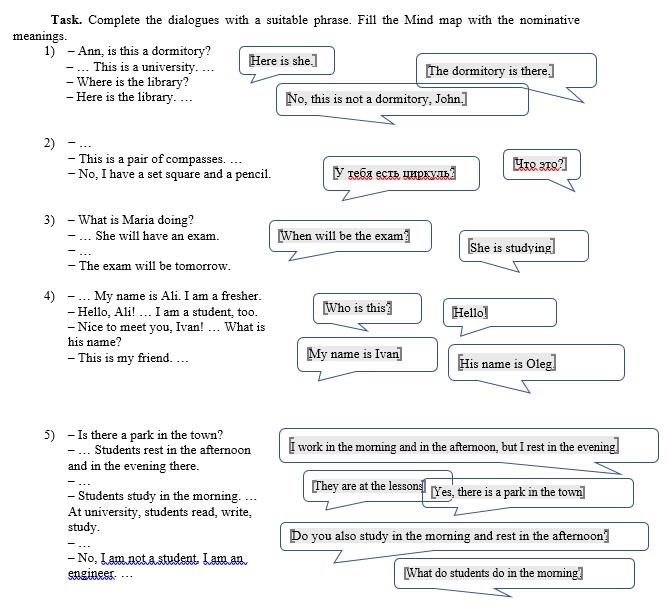
At the basic level of RCT learning, new meanings are added to the mind map presented.
The construction 'What is called+ N1' should be added to the already known to foreign students 'name', where the construction with the verb 'is called' is used:
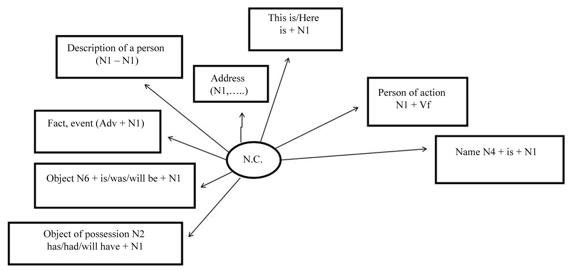
– Lena, do you know when the exam will be?
− The exam will be tomorrow.
− When does the exam start?
− The exam starts at 9 o'clock.
– Hello students! What is the date today?
− Hello, Maria Ivanovna! Today is Tuesday, December 5th.
− Today we will have a test.
– Mark, what do you do in the evening?
− In the evening I do my homework and rest. I read books and watch movies.
− What do you do in the afternoon?
− In the afternoon I study at the university. Classes start at 9 o'clock and finish at 3 o'clock.
The mind map is supplemented with three constructions (highlighted in color, highlighting is not needed in students' mind maps):
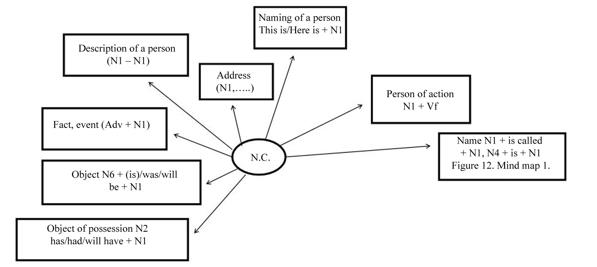
Make sentences according to the model (use the words нужен, нужна, нужно). Add a new meaning to the mind map.
Model: Student – computer → Student needs a computer.
Teacher – marker.
_____________________________________________________________________________________
Library – books.
_____________________________________________________________________________________
Journalist – camera.
_____________________________________________________________________________________
Woman – mirror.
_____________________________________________________________________________________
Add the construction 'N3 + needs + N1'.
Task 4. Describe the pictures. Use the reference words and say who has/had/will have what. Fill the mind map with a new nominative meaning.
Reference words: allergy, headache, toothache, bad mood, good mood.
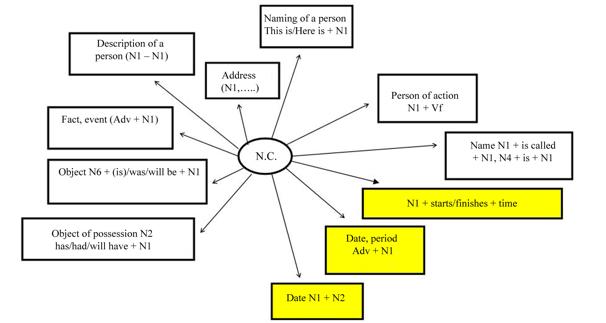

В1 level
At this level, the algorithm for working with mind maps remain the same.
Describe the pictures according to the model. Find a new nominative construction and add it to the mind map.
Model:
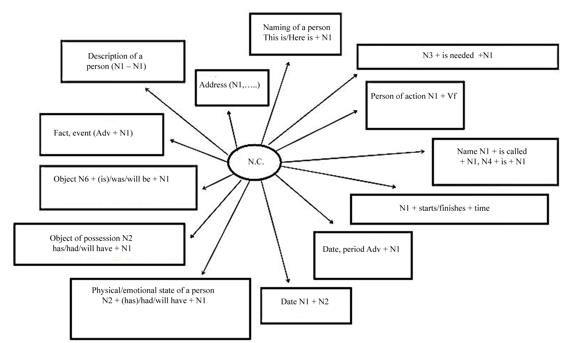
Answer the questions using the highlighted word in your answer. Add a new construction to the mind map.
Model: − What is? − is a shop.
− Where is the hospital? − Here …
− Who is? − …
− Who is? − …
− What is? − …
− What is? − …
The already known construction 'This + N1' is supplemented with new words highlighted in bold in the exercise.
Compare the pictures using the comparative form of adjectives and the word 'than'. Add a new construction to the mind map.
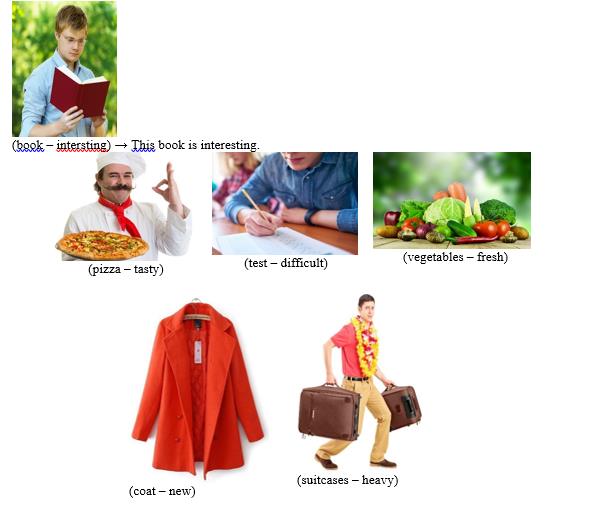
John – sport; Maria – dancing; I – these photos.
Add the construction 'N3 + likes + N1' to the mind map.
Change active constructions into passive ones using the words given in the brackets. Add new constructions to the mind map.
An experienced doctor performs complex operations (to be done) → ...
Russian poet wrote new poems (to be written) → ...
Foreign students study physics and higher mathematics (to be studied) → ...
Mom bought fresh fish (to be purchased) → ...
The two constructions expressing one meaning – passive voice: 'N1 + V + N5', 'N1 + Participle passive + N5' are added to the mind map.
The final task is performed in the lesson to revise the meanings of the nominative case known to students and check the resulting mind map. The final task can be given as the text, which includes all the meanings of the nominative case (A1–B1 levels):

Conclusion
The fishbone and mind map innovative techniques adapted by the authors enable transformation of the linear textual presentation of educational information into polycode texts and algorithms that are easier to perceive and more efficiently mastered by foreign students of engineering specialties. The authors believe that it is especially important to use the above techniques when studying a complex prepositional-case system of the Russian language. The results of the experiment show that the use of innovative fishbone diagrams and mind maps makes it possible to visualize and systematize complex grammatical information, and reduce the number of mistakes associated with confusion or ignorance of the case meanings in different constructions. The authors plan to continue developing the methodology for using innovative techniques in teaching RFL.
Acknowledgments
The publication has been prepared with the support of the RUDN University Program 5-100.
References
Akhmedova, E.M. (2020). Actual aspects of using the technology of mind maps in the pedagogical process. World of Sci., Culture, Ed., 2(81), 310312.
Andryushina, N.P. (2009). Requirements for Russian as a foreign language. First level. General knowledge. Second option. Moscow; St. Petersburg: Zlatoust.
Andryushina, N.P., Kozlova, T.V. (2015a). Lexical minimum in Russian as a foreign language. Basic level. General knowledge. St. Petersburg: Zlatoust.
Andryushina, N.P., Kozlova, T.V. (2015b). Lexical minimum in Russian as a foreign language Elementary level. St. Petersburg: Zlatoust.
Buzan, T. (2002a). Head First (10 Ways to Tap into Your Natural Genius). London: Thorsons.
Buzan, T. (2002b). How to Mind Map (The Ultimate Thinking Tool That Will Change Your Life). London: Thorsons.
Buzan, T. (2004). Mind Maps at Workand How to Be the Best at Your Job and Still Have Time to Play. London: Thorsons Element.
Gelb, M.J., Buzan, T. (1996). Lessons from the Art of Juggling (How to Achieve Your Full Potential in Business, Learning and Life). New-York: Crown Trade Paperbacks.
Goncharova, V.P., Shitova, I.Yu. (2015). Mindmaps: the Tools to Visualize Mental Activity. Bull. of Vernadsky Crimean Fed. Univer. Sociol. Pedag. Psychol., 1(67), 7377.
Ishikawa, K., Loftus, J.H. (1990). Introduction to Quality Control. Tokyo: 3A Corporation.
Kalinina, Yu.M., Mikheeva, E.S. (2019). Innovative techniques in the practice of teaching RFL. Prepositional-case system of the Russian language (Fishbone and Mind map techniques) Moscow: IP N.V. Alontseva.
Nakhabina, M.M. (2001). State Standard for Russian as a Foreign Language. Basic level. Moscow; St. Petersburg: Zlatoust.
Syrina, T.A. (2016). Cognitive visualization-essence and methods of teaching language. Bull. of TSPU, 7(172), 8185.
Vladimirova, T.E. (2001). State Standard for Russian as a Foreign Language Elementary level. Moscow; St. Petersburg: Zlatoust.
Copyright information

This work is licensed under a Creative Commons Attribution-NonCommercial-NoDerivatives 4.0 International License.
About this article
Publication Date
17 May 2021
Article Doi
eBook ISBN
978-1-80296-106-5
Publisher
European Publisher
Volume
107
Print ISBN (optional)
-
Edition Number
1st Edition
Pages
1-2896
Subjects
Science, philosophy, academic community, scientific progress, education, methodology of science, academic communication
Cite this article as:
Mikheeva, E. S., Kalinina, Y. M., Abyshkina, V. V., & Tugova, Y. A. (2021). Visualization Techniques For Prepositional-Case System In Teaching Russian Language For Foreign Students. In D. K. Bataev, S. A. Gapurov, A. D. Osmaev, V. K. Akaev, L. M. Idigova, M. R. Ovhadov, A. R. Salgiriev, & M. M. Betilmerzaeva (Eds.), Knowledge, Man and Civilization - ISCKMC 2020, vol 107. European Proceedings of Social and Behavioural Sciences (pp. 2777-2792). European Publisher. https://doi.org/10.15405/epsbs.2021.05.369

